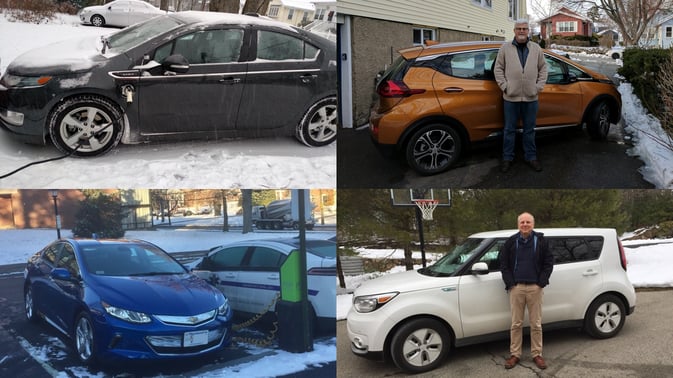Why efficiency matters for electric cars
Electric vehicles (EVs) are better for the environment than gas-powered cars not just because gas-powered cars...

As you may have noticed, it's gotten to be *really* cold recently. Electric vehicle (EV) performance does change in winter, but so does that of gas-powered cars.
There are thousands of EV drivers who drive through winters in New England (and even colder places like Canada and Norway) with their EVs every year. Here’s what New England winter weather will do to your EV and tips from other EV owners.
Your range will decrease. Batteries operate less efficiently when it’s cold, so a cold battery will get fewer miles per kilowatt-hour than a warm battery. As a result, a full charge will not get you as far in February as it would in April. Generally, the ratings on miles per charge have been shown to be accurate on a year-round basis. For most of the year, EV drivers can expect to exceed their car’s rating, but on cold days, we can expect less than the car’s rating.
Many modern EVs have a system that heats up the battery to keep it operating at an optimal efficiency. However, heating the battery consumes some of the electricity the battery is storing, so this measure decreases range. In addition, because EV’s drivetrains don’t squander energy by creating waste heat like gas-powered cars (60% of the energy created by burning gas is lost to waste heat!), you will have to use some of the battery power to heat the car to a comfortable temperature. All of these factors mean your EV’s range will decrease when it’s cold. With that said, gas-powered cars’ ranges also decrease in the cold (by 20% or more when it’s freezing) and there are simple steps you can take to get the most out of your EV in the winter, which we’ll discuss below.
Driving in snow and ice will be… fine. Electric vehicles generally have a low center of gravity and evenly distributed weight, which make them easy to maneuver and get you good traction. In many EVs, the battery essentially forms the floorboard of the vehicle, which adds extra stability. Yes, you’ll make it up that hill or through that lump of snow! There are not many EVs available yet with all-wheel drive, but there are several models on the way.
You don’t need to buy a second car for the winter or restrict your driving radius. To get the most out of your EV, we recommend that you:
Precondition your vehicle. “Preconditioning” means heating up your car’s battery while it’s still plugged in. (Most cars will allow you to start preconditioning remotely via cell phone.) This way, your battery warms up and operates more efficiently when you start to drive but you don’t have to deplete your battery’s reserves to heat it. Not to mention that you step into a warm vehicle when you’re ready to leave, so you won’t need to crank the heat as much when you unplug. It’s a win-win-win!
Use the special heating features of your vehicle. Most modern EVs offer seat warmers and heated steering wheels. Use these features! They require less energy than heating the air and will make you feel comfortable even if you keep the cabin air temperature slightly lower.
Drive efficiently. Turn on regenerative breaking or set your car in eco-mode. By capturing any energy that might otherwise be lost, you’re extending the range of your car. If ever there was a time not to speed, it’s when it’s cold outside. Speed increases drag and drag reduces mileage.
Clean off your car. Chunks of snow and ice weigh down your vehicle and compromise its aerodynamics, both of which will reduce your range.
Put on a sweater or keep on your coat. We are all used to driving in toasty cabins because we have become accustomed to the heat of incredibly inefficient gas engines. It’s obvious, but if you keep on your coat or put on a sweater (gloves are a good idea too), you’ll need to heat the cabin less and your battery will thank you.
Park and charge somewhere warm. If you can park and charge your EV someplace warm, your battery will be glad. For example, if you park outside, parking on the sunny side of the parking lot rather than the shady side will make a difference.

Electric vehicles are no strangers to snow!
Here’s more great advice from the US Department of Energy.
Long story short, you don’t need to worry: EVs can handle whatever New England can throw at them. If you have any other tips for EV drivers that we’ve missed, let us know in the comments!
And if you’re ready to get your EV, sign up for our discounts here.
Electric vehicles (EVs) are better for the environment than gas-powered cars not just because gas-powered cars...
In my previous blog post, I wrote about the role better battery technology could have in the proliferation of...
Comments